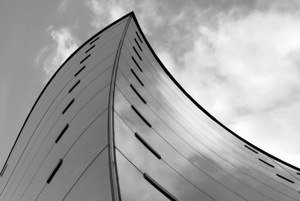Polycarbonate sheet is extruded by large production lines. The more specialty lines typically extrude 3,000 lbs/hr, while commodity lines extrude 5,000-10,000 lbs/hr. For some of the large lines, if they take ten minutes to change dimensions, they could easily generate over 1,000 lb of off specification material, which will either need to be recycled or scraped.
Non-standard width
The maximum width of the polycarbonate sheet is governed by the width of the die installed on the line; most large lines have a die that can produce 96” wide sheet. The extrusion lines produce most efficiently when they are running at maximum throughput, which means running the maximum width of 96”. One option that sheet extruders have is to cut the sheet in half while the sheet is being produced, this process will give two sheets of 48” wide. The widths of 48” and 96” are some of the most common widths. Because they can be produced cheaply they have become industry standards and are nearly always in stock at the major producers and distributors.
If a customer needs a non standard width, this can be achieved by extruding 96” wide material through the die and then cutting down the edges by in line saws. Any off cut material can then either be recycled or sold as scrap. If a customer needs dimensions such as 95” wide or 47” wide, there will not be much scrap generated, even though the material would still need to be custom produced. If the customer needed a width such as 75”, proportionally more scrap would be generated and the cost to produce would go up. For widths of say 60”, the scrap ratio would be too high and the producer could stop the line and block off part of the die to limit the width of the sheet being produced. The stoppage would obviously lead to lost production and then the machine would be run at a lower, more inefficient rate because the die width would be lower. All of these factors add to the cost.
Non-standard length
The length of the polycarbonate sheet is more easily controlled. During production an in-line cross cut saw is used to cut across the sheet. The length can be set to almost any value (as long as it is not too small). It is therefore possible for a producer to make custom lengths without too much additional cost.
Non-standard thickness
For stocking purposes the major producers have standardized on a number of thicknesses – 0.060”, 0.118”, 0.177”, 0.236” are some examples. These sizes are normally carried in stock in both 48” x 96” and 72” x 96”. Adjusting to another thickness really only involves some minor changes to the die and chrome polishing rolls; these changes are quick and do not generate much off specification production.As a consequence, non-standard polycarbonate sheet thicknesses are not difficult to produce, but manufacturers normally insist on a reasonable minimum order size. Also manufacturers will normally only produce non-standard thicknesses against an order, as they do not have a general need for the material. Because the material is custom produced, manufacturers often quote a long lead-time.
Non-standard color
For custom colors, introducing a new color to the line causes a lot of scrap changeover material between the production of the old color and the production of the new color. The lines are not shut down and cleaned between color changes, as that would be too inefficient. Manufacturers dislike frequently changing colors, and often plan large color runs to improve efficiency. Asking a manufacturer to stop the production of a clear polycarbonate sheet to produce a few hundred pounds of a red material is not likely to be received well, as the change-over produced from going from clear to red and then back to clear is likely to be many thousands of pounds. A manufacturer can not offer a competitive price if they produce ten or more pounds of scrap for every pound of good product.
Summary
Standard production sizes and colors have been established to improve efficiency and reduce cost. If a customer needs a non-standard product it is likely to be more expensive and require greater lead-time and larger minimum orders. Non-standard colors are the most costly, followed by non-standard width, followed by non-standard thickness, with non-standard lengths being reasonably cheap to produce. Considering these factors during product design can help in minimizing later costs and ensuring availability for the customer.

